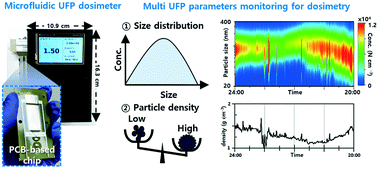Microfluidic ultrafine particle dosimeter using an electrical detection method with a machine-learning-aided algorithm for real-time monitoring of particle density and size distribution†
Abstract
Growing concerns related to the adverse health effects of airborne ultrafine particles (UFPs; particles smaller than 300 nm) have highlighted the need for field-portable, cost-efficient, real-time UFP dosimeters to monitor individual exposure. These dosimeters must measure both the particle density and size distribution as these parameters are essential to the determination of where and how many UFPs will be deposited in human lungs. However, though various kinds of laboratory-grade instruments and hand-held monitors have been developed, they are expensive and only capable of measuring particle size distribution. A microfluidic UFP dosimeter is proposed in this study to address these limitations. The proposed sensor, based on an electrical detection method with a machine-learning-aided algorithm, can simultaneously measure the size distribution (number concentration, mean mobility diameter, geometric standard deviation) and particle density, and is compact owing to the microelectromechanical systems (MEMS) technology. In a comparison test using physically synthesised Ag and di-ethyl-hexyl sebacate (DEHS) aerosols, the mean measurement errors of the proposed sensor compared to the reference system were 6.1%, 4.5%, and 7.3% for number concentration, mean mobility diameter, and particle density, respectively. Moreover, when the machine-learning aided algorithm was operated, the geometric standard deviation could be deduced with a 7.6% difference. These results indicate that the proposed device can be successfully used as a field-portable UFP sensor to assess individual exposure, an on-site monitor for ambient air pollution, an analysis tool in toxicological studies of inhaled particles, for quality assurance of nanomaterials engineered via aerosol synthesis, etc.

- This article is part of the themed collection: Lab on a Chip HOT Articles 2021


 Please wait while we load your content...
Please wait while we load your content...